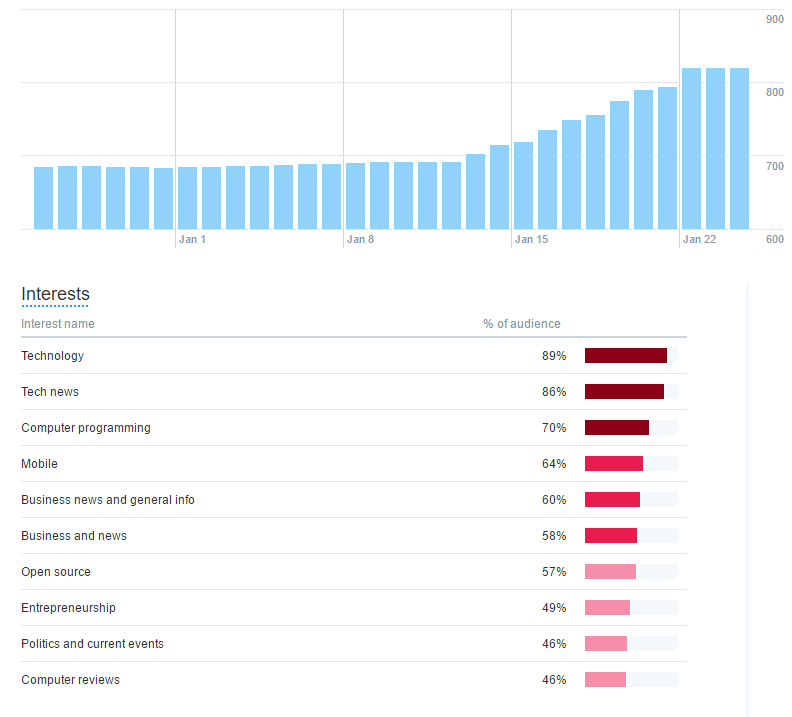2017-03-02
Testing the Twitter API
Wil-Low is a company led by engineers, and engineers are curious people. In January, we did a manual test with the Twitter account of one of our customers, iText Group NV. We harvested a selection of Twitter handles belonging to people who might be interested in PDF software (which is the core business of the iText companies).
For 10 days in a row, we manually followed 50 accounts from that selection. That's 500 accounts in total.
Results of the manual test
After 10 days, we looked at the result:

About 20% of the people we followed, started to follow us back. This way, the number of followers increased with about 18%.
Based on this initial result, we decided that it was worthwile to spend some time on developing an application that automated our manual procedure.
Using the Twitter API

We started experimenting with the Twitter API, and soon we bumped into some problems. Early adopters of Twitter certainly remember the following "Fail Whale" image.
This "Fail Whale" was presented whenever the servers at Twitter were in trouble. In 2013, Twitter made it mandatory to authenticate when using its API. On the one hand, this was a way to avoid abuse (the API could no longer be used anonymously); on the other hand, this allowed Twitter to define API Rate Limits for the use of specific functionality.
Some examples:
- You can only send 250 Direct Messages a day,
- In a time window of 15 minutes, you can only request a "friends" list 15 times, call the "show user" method 900 times, and so on.
- You can only follow 5,000 accounts unless you have 5,000 followers. Once you have 5,000 followers, you can follow 110% of the number of followers you have. That is 5,500 if you have 5,000 followers; 11K if you have 10K followers, and so on.
Although we never exceeded these limits intentionally, we've hit these limits a number of times due to bugs that were introduced while writing our code. At some point, we decided to create a separate account Productivate 101 just for testing. Funny but true, even that separate account that served no other purpose but testing our code, got quite some traction from followers.
The results
The goal was to get more followers for the iText account, keeping an eye on the audience. iText is a technology provider that allows developers to enhance their products and applications with PDF functionality. It may have been easy to get more followers interested in topics such as politics, fashion, or any other subject, but iText Group was interested in getting more followers interested in Technology, Tech News, and Computer Programming. Whatever algorithm we put in place, it was important not to dilute the interest percentages in those categories.
Let's take a look at the results:

As you can see, we gained 673 extra followers in less than a month. Today, the algorithm is still in place, but in a less aggressive way. @iText gains a handful followers a day, and the audience consists of exactly those people that iText wants to address:

We were even able to increase the percentage of people interested in Technology and Tech News. The impact on the overall performance of the account was also impressive:

226.7% more mentions, 226.8% more profile visits, and 31.5% more tweet impressions. Isn't that just great?
Can this be done with any account?
Once we started seeing results for the @iText account, we wondered if the algorithm could also be used for one of our personal accounts, more specifically @bruno1970. The answer is Yes! and the increase was even more spectacular:

The audience of this personal account is quite similar to the audience of the iText account:

The topics Technology, Tech News, and Computer programming aren't surprising since Bruno Lowagie (@bruno1970) is the original founder of the iText Group, but the topics Entrepreneurship and Business news and general info are very much on-topic too.

In spite of the fact that there were 20% less tweets, there were 161.5% more mentions, a whopping 562.45% more profile visits, and 83.2% more tweet impressions. Those results are even better than the results we had with the iText account.
One possible explanation is that @bruno1970 is a personal account, whereas @iText is the account of a business. People would probably rather follow a person than a company, but let's do another test. What if we try to get followers for an account that was created for testing purposes only?
Can this really be done with any account?
We decided to put the algorithm in place for our @productivate101 account, and much to our surprise, people started to follow us:

We created this test account on February 11 and less than 20 days later, it already has 255 followers. We decided to retweet random tweets from a couple of accounts that were selected based on their expertise. Apparently this was sufficient for people to follow us. We created an audience that was interested in Technology, Tech news, Entrepreneurship, Marketing, and Leadership.

Actually, that's the type of audience that would be interesting for our own @willow9040 account. We should consider putting the algorithm in place for that account too (we currently only have 4 followers).
Conclusion:
We have done an interesting experiment with some very interesting results in a very short term. The tool we have built for fun now runs automatically, and we are very curious about the long-term effect: what will happen once we get closer to the 5,000 friends limit? Will there be a saturation point where we just can't find any more people who are interested in iText or in the other accounts? Only time can tell. In three months, we'll take another look at the Twitter Analytics pages, and we'll publish our findings in a follow-up blog post.




